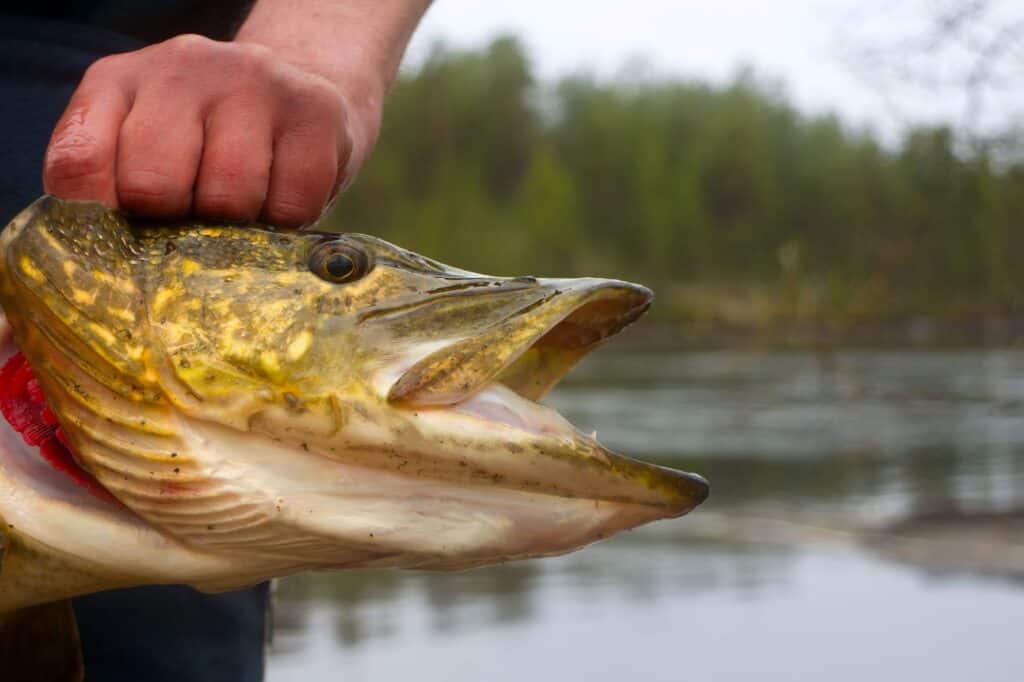Pike and Muskie. Two of the most commonly confused fish in North America. The difference between these two types of freshwater fish can be tough to distinguish, especially for newcomers to angling. In this blog post, we will discuss some of the major differences between a Pike and a Muskie so you can tell them apart next time you are on the water!
How can you tell a muskie from a pike?
Pike and muskie are two different kinds of fish. You can tell them apart if you know what to look for.
- A Pike has a dark spot on the top of its head, whereas a muskie does not.
- A Muskie has a pointed snout, while a Pike does not.
- A Pike has a serrated dorsal fin, while a Muskie’s fins are smooth.
- A Pike has smaller scales than a Muskie.
- A Muskie will grow larger than a Pike.
- Pike commonly live in smaller streams, lakes, and ponds, while Muskies usually live in larger bodies of water like major lakes and rivers.
- The lifespan of each fish varies depending on its habitat and size at birth. Muskies can live up to 50 years in the wild with proper care, while pike can only live up to 20 years in the wild.
- Muskie’s have teeth on their lower jaw, while Pike’s do not
- Pike have been known to venture into brackish water; Muskie will not.
Is a muskie a type of pike?
Muskie is not a type of pike. The difference between these fish species are quite considerable, and they should not be confused with one another as they have major differences in their appearance and habitat preferences.
The first difference between these two types of freshwater fish is in their colors. Pike tend to be bluish-green, while Muskies have pinkish or reddish scales on their back when mature.
This difference can help you identify which species it belongs to if observed from afar by looking at how the water reflects off its scales before getting too close for observation details like gill rakers.
Another difference would be size: Pike generally grows between 16-22 inches long while Muskies have been reported up to 6 feet.
Where do pike and muskie live?
Pike and Muskie inhabit a wide variety of habitats. Pike live in lakes, rivers, ponds, and streams. Musky are mainly found in slow-moving waters like marshes or backwaters behind dams where they can feed on smaller fish species that abound there.
However, it is worth noting that pike can be found living in more than just freshwater; some have been spotted in the brackish water of the Baltic Sea.
Both pike and muskie are ambush predators. They prefer to hang out under cover of vegetation or weedbeds and wait for unsuspecting prey to pass.
Can you eat a Muskie?
Muskies are considered too oily and bony for most people’s tastes. The flesh of the fish is dark but has a delicate flavor not unpleasant to some palates, similar to that of freshwater codfish or walleye pollock.

Can you eat pike?
Pike are great freshwater sport fish, and while they have a good flavor, the flesh has quite a lot of bones.
Pike has very tasty meat and has more bones than one might expect in this type of gamefish. Pike’s skin has scales that make it difficult to clean, and they’re more durable than those on salmon or trout species, making them hardier during spawning season when they fight with others over territory.
Will muskie bite you?
Muskie is generally not considered a threat to the average swimmer. While their teeth are very sharp, they have little interest in you. There have been few rare reports of it happening; it isn’t something you need to be too worried about.
If you an angler who has landed one of their awesome fish, you need to take some extra caution. You are more likely to get caught by one of their teeth while removing a hook. This is a result of the Muskie moving around rather than aggression.
Can pike bite your finger off?
Pike are not normally seen as a threat to humans. Pike feed on smaller fish and small mammals under the water, which they grab with their long jaws. While they have strong, sharp teeth in both plates of their jaw, pike cannot bite down hard enough to actually take off someone’s finger or toes if they get too close.
Conclusion
As you can see, the difference between these two types of freshwater fish is quite considerable, and they should not be confused with one another as they have major differences in their appearance and habitat preferences. Whether you’re an angler who has landed a Muskie or someone who prefers to eat pike for supper, it’s important to know how to identify which species it belongs to.
We hope this article helped identify some key distinctions between Pike and Musky so that you are better able to make your selection at the fishing store next time!
If you find this article helpful, don’t leave without sighing up for our newsletter and checking out our Recommended Fly Fishing Gear List.
Don’t forget to check out our other Fish Guide articles.
- Are Bass Good To Eat?
- What’s the Difference Between Trout and Salmon?
- Are Bonefish Good To Eat?
- What’s the Difference Between Carp and Buffalo Fish?
- Are Pike Good To Eat?
- The 7 Best Secret Rainbow Trout Baits
- Best Powerbait For Stocked Trout
- What Is The Difference Between Walleye And Pickerel?
- What Is A Tiger Trout? Where to Find One and How To Catch One


